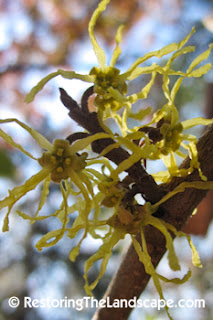 |
| American Hazelnut ~ Corylus americana |
Out of all the native shrubs in my own regional landscape, two that stand out as very dependable understory shrubs are American Hazelnut (
Corylus americana) and Downy Arrowwood Viburnum (
Viburnum rafinesquianum). Both of these shrubs are fairly common, growing in the understory of oak dominated woodlands, as well as on the edges in thickets.
American Hazelnut flowers before the leaves emerge in late March to early April. The male catkins elongate and dangle from the branches, an attractive trait of this native shrub.
The female flowers are more inconspicuous, attached the branch in a small scaled catkin. The bright red stigmas protrude from the ends of the female flower and catch the wind dispersed pollen.
Hazelnuts form in clusters from the pollinated female catkin. The nuts are covered with a frilly bract that turns from yellow-green to light brown as the nuts inside mature. The nuts are a favorite food of squirrels and chipmunks.
American Hazelnut is an excellent shrub for understories or shady, well drained landscapes. It performs well under tree canopies providing good understory cover for birds and small mammals. It has a suckering habit, new shoots arise around the older stems. The large coarse leaves are very attractive and the overall form is an upright and branching.
American Hazelnut can reach heights of 15 feet or more in moist rich soils, but in drier upland sites, it's more commonly around 6 feet in height.
Downy Arrowwood Viburnum is also a good candidate for dry shady locations. We had a small patch of this shrub existing in our landscape when we moved into our house and have since added more.
Downy Arrowwood flowers in mid to late May, tiny 5 parted white flowers arranged in a cyme.
A slender multi-stemmed shrub, that can reach heights of 10 feet when mature. There are some beautiful mature specimens at a local park, that have a vase shaped form with most of the leaves near the top of the cluster.
Downy Arrowwood also suckers, forming thickets in more open areas. It has extremely attractive leaves, with deep veins and coarsely serrated edges. I have had great success adding more of this shrub into my dry shaded woodland.
Fall foliage color on Downy Arrowwood is spectacular, anywhere from pink-tinged to maroon to bright red.
Spring migrating warblers always stop in our yard to investigate what insects they can find on both of these native shrubs. Other ground foragers such as robins and sparrows seem to like the cover these medium sized shrubs provide in our woodland landscape.













































